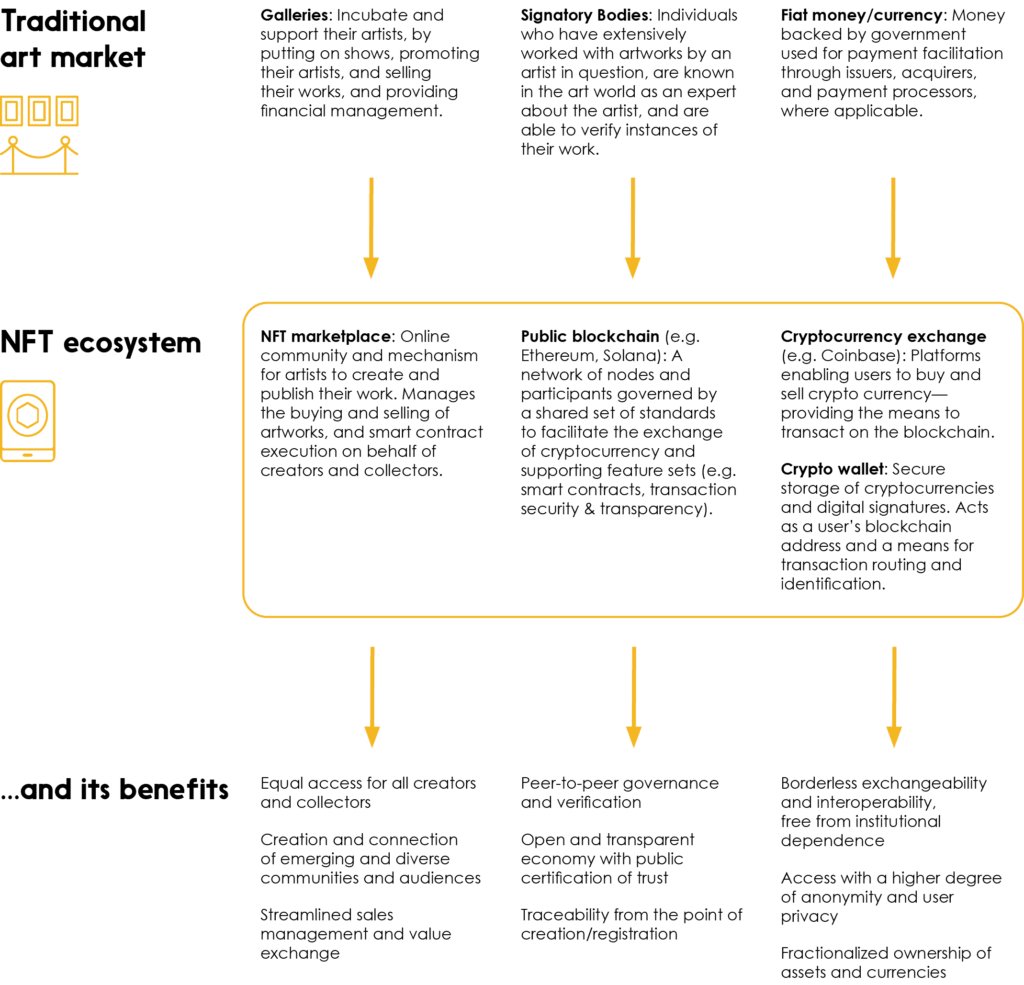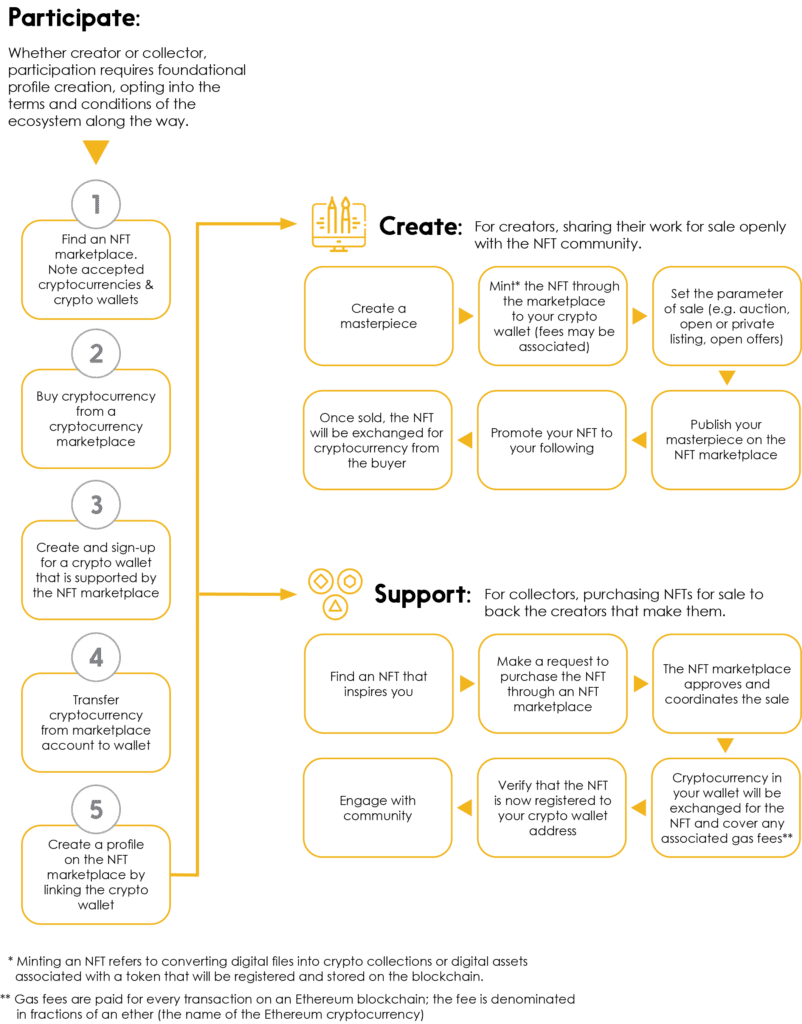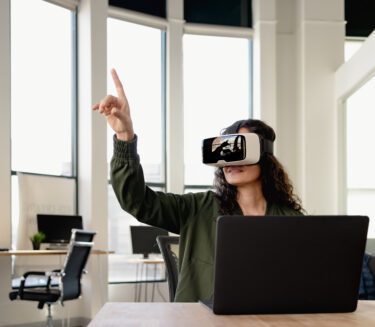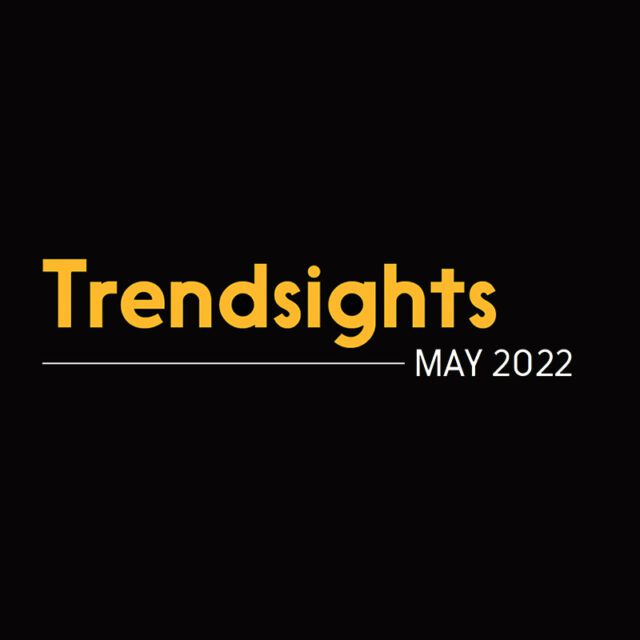If the metaverse is the future of the Internet, then NFTs (non-fungible tokens) are one of its most important new goods.
Much like how the deed to a home is registered with a government in the physical world, NFTs are used to prove the ownership of an asset on a blockchain in the digital world. NFTs can be used to represent physical objects, digital content, event tickets—or even intangible concepts like space or identity. Individuals are beginning to place greater value on virtual-based items and technologies, and NFTs are already redefining the experience of creating, authenticating, acquiring, owning, and investing in digital goods.
While the art market is progressive in expression, its gatekeepers have always been fixed and its promise to serve as an open exchange for all creators (emerging or established) and their supporters has gone unfulfilled. Web 3.0 promises the ability to transfer value, information, and knowledge in fresh ways—among other things, democratizing access and shifting ownership and control back to content creators. Though with this colossal power shift, we must ensure that those original promises become accessible to all, rather than to the select few, yet again.
This edition of Trendsights will unpack the NFT ecosystem and what this technology might mean for the future of value exchange, and for the role of creators, collectors, and the communities surrounding them all.
What is an NFT?
NFTs exist only in the context of blockchains, so let’s start there.
A blockchain (also referred to as form of distributed ledger technology, or DLT), at its core, is a system of recording information in a way that minimizes or eliminates incentives to change, hack, or cheat the underlying system—typically doing so through both on-chain governance and the participation and agreement of users in the implementation of changes to a given blockchain. This principle of decentralization is key: Bitcoin demonstrates the ability to decentralize currency away from the control of a single government, while programmable blockchains like Ethereum decentralize authentication—which in turn enables NFTs.
NFTs are unique and non-interchangeable units of data stored on blockchains, and they are typically associated with reproducible digital files such as photos, videos, and audio. NFTs use the blockchain they’re hosted by to provide a public certificate of authenticity or proof of ownership, which at the same time does not restrict the sharing or copying of the underlying digital files.
Their lack of interchangeability (i.e. their non-fungibility) distinguishes NFTs from blockchain cryptocurrencies, which are easily exchangeable for other digital currencies.
Leveraging smart contracts and open standards*, thus embedding programmability, the NFT ecosystem ensures seamless transfer and immutability of ownership.
Common DLT properties
Programmable: A global computer where the results of every computation can be seen by anyone.
Smart contracts: Programs stored on a blockchain that run when predetermined conditions are met. In some ways, they can mimic and be treated as legal agreements.
* See, for example, ERC-721, which describes how to build non-fungible tokens on the Ethereum blockchain: http://erc721.org
NFTs: Not your parents’ art market
While the traditional art industry is founded on privileges of access and scale that are afforded to a select few, the emerging NFT ecosystem disrupts this, overcoming challenges of provenance, access, promotion, and authenticity for its community members.

NFT Ecosystems
NFT Creators
Supporting and empowering creators requires access, tools, and knowledge to reduce barriers and create opportunities to access customers and markets for non- traditional and under-represented artists.
As with any new technology, the complexities surrounding NFT usage is barricaded by the similar hurdles but in the form of knowledge and technology. Creators are left to navigate the multi-faceted, multi- player exchange landscape where accountabilities are unclear and at times unregulated.
The creator (independent, institutional, or otherwise) takes on unknown risks in exchange for autonomy, control, and potential financial gain of their creations.
NFT Collectors
Whether hobbyists or speculators, collectors place value on collectibles based on two factors: authenticity and scarcity. Digital assets are often easily replicated but NFTs make these two factors relevant, providing a framework for digital ownership.
NFTs enable peer-to-peer exchange of collectibles without the need for third party verification, enhancing trust while reducing administrative costs.
This presents collectors with the opportunity to interact with and support creators more directly in an open marketplace which forms the basis of community discovery and engagement.
NFT Community
Community helps generate attention, conversation, and the assignment of value—thus becoming as important as the collectibles, creators, and collectors themselves. Deeply rooted in shared values, they shift control and power wherever it reaches consensus.
Leveraging innovative solutions that empower the voice of community can solve issues that have plagued the industry (access, promotion, education).
The influence of community challenges existing systems to become more beholden to the masses rather than to those of the selected few acting on their behalf.
How to start your NFT exploration
Though the user experience may differ between the multitude of NFT platforms and options, the following aims to capture the most typical activities required.

Considerations and opportunities
Industry governance
While blockchain standards look to regulate the behaviour of digital systems, governance structures for the industry lag behind the technical advancements in the NFT ecosystem. The entities that operate these emerging exchange platforms need to be incentivized to build these platforms for social benefit. Keeping pace with the decentralization of authority requires industry (both institutional and emerging bodies) collaboration and a collective ruleset to ensure that all actors are creating inclusive solutions.
Authentication & trust
For the metaverse and NFTs to function at scale, there is a need for trusted facilitation and execution of seamless value exchange. Integrating existing systems built around strong KYC with decentralized self-sovereign identity systems can deliver the needed digital authorization and verification services. Consumer comfort and trust in the digital world needs to be built on top of our foundational identity practices, while at the same time striking the right balance between transaction anonymity and robust security that can be made available to all participants.
Disclosure & wealth distribution
Though transactions on the blockchain may be transparent, the business models behind crypto projects are too often opaque. Endorsing NFTs as a viable investment vehicle is still largely speculative, however the ability to directly support a creator’s work remains a genuine value proposition. Empowering communities to directly support collective needs should be placed at the forefront of our priorities, ensuring that creators and collectors have access to institutions traditionally impenetrable by marginalized and under-represented communities.
The future of NFTs
Building on the programmability of DLT and democratized access to sophisticated signing authority, the utility and use cases for NFTs will continue to expand and become more entrenched in our daily lives.
A more NFT-involved future, however, may be undermined if we fail to build trust and inclusivity from the beginning.
As blockchain-based projects are typically based on some level of speculation, we too often see early adopters taking advantage of their position to enrich themselves. These actions end up undermining the development of a broader community spirit and spawn irreversible inequities. To create equitable outcomes, industry must support education and access to systems from the beginning. Emerging solutions need to be founded on an equity-by-design approach for all to participate in and try out these new experiences, while gathering widespread feedback along the way.
While there is much promise in the future for NFTs, it does not come without its set of concerns. If NFTs are to become a growing part of our future lives, it is up to those in the know (creators, collectors, community), as well as the curious and even the presently unaware, to challenge the gatekeepers, both traditional and emerging, in a push to shape a more equitable and inclusive landscape.
Did you miss our last Trendsights reports?
Catch up on the Metaverse and Central Bank Digital Currencies now.





